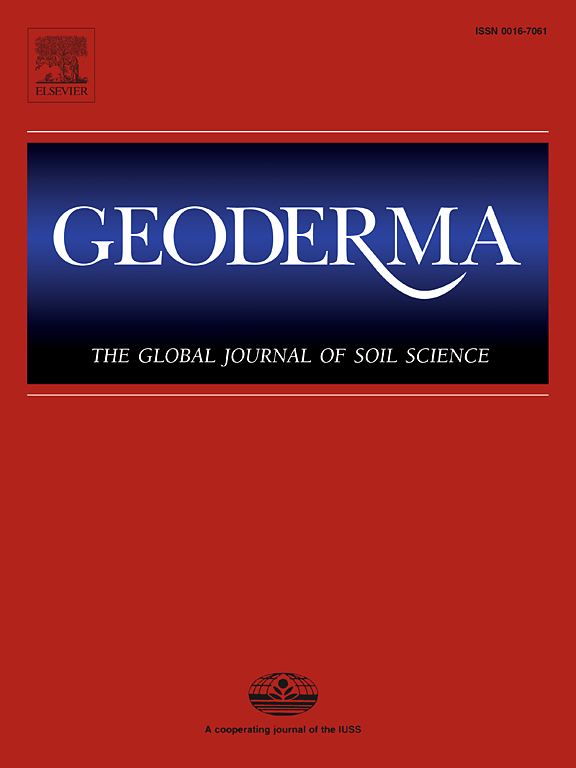加利福尼亚温带森林岩性和生物气候对土壤有机磷形态的影响及磷酸酶与有机磷的关系
IF 6.6
1区 农林科学
Q1 SOIL SCIENCE
引用次数: 0
摘要
土壤磷酸酶活性与土壤有机磷的动态平衡受土壤形成因子的影响。虽然许多研究已经利用时间序列解决了土壤磷动态作为时间函数的问题,但对岩石和生物气候对土壤磷循环的影响的理解仍然相对有限。我们利用三种岩性(安山岩、玄武岩、花岗岩)和四种生物气候带(蓝橡树、黄松、白杉、红杉)的全因子组合,测试了假设的岩性和生物气候对土壤Po的数量和质量的相互影响,以及Po组成与磷酸酶活性之间的关系。这些生物气候带受美国加州内华达山脉和南喀斯喀特山脉海拔范围的限制。NaOH-EDTA萃取和溶液31P核磁共振(NMR)测定了酸性、碱性磷酸单酯酶(PME)和磷酸二酯酶(PDE)活性与Po浓度呈正相关。PME活性与Pi、Po种和种级(即磷酸单酯、磷酸二酯)浓度呈正相关,而PDE活性与P种在种级水平的磷酸二酯浓度呈正相关。在安山岩上发育的土壤中,六磷酸肌醇(IHP)和大多数非六磷酸肌醇单酯(如葡萄糖-6′磷酸、α-和β-甘油磷酸、磷胆碱)、磷酸二酯(即脱氧核糖核酸)和无机磷酸盐(即(热)磷酸盐)的含量高出68 - 232%(单酯312 mg kg - 1;二酯25 mg kg - 1),其次是玄武岩(单酯174 mg kg - 1;双酯20 mg kg - 1),花岗岩中最低(单酯133 mg kg - 1;diester 12 mg kg−1),反映了中间母体材料中较差结晶的Fe/Al氧化物和P的含量较高。生物气候对磷元素浓度和比例的影响与岩性密切相关,安山岩土壤(单酯265 mg kg - 1)和玄武岩土壤(单酯67 mg kg - 1)的磷元素浓度在海拔最高的地方(红杉)最低,而花岗岩土壤(单酯108-183 mg kg - 1)的磷元素浓度基本不受生物气候的影响。磷酸酶活性与磷物种浓度之间的关系主要发生在基性物质源性土壤中,并且在特定的生物气候条件下对磷物种具有高度的特异性。结合岩性和生物气候背景可以更全面地评价土壤磷循环。本文章由计算机程序翻译,如有差异,请以英文原文为准。
Lithology and bioclimate impacts on soil organic phosphorus speciation and the relationship between phosphatase and organic phosphorus in California temperate forest
The dynamic equilibrium between soil phosphatase activities and soil organic phosphorus (Po) species can be impacted by soil forming factors. While much research has addressed soil Po dynamics as a function of time using chronosequences, understanding of lithology and bioclimate impacts on soil P cycling remains comparatively limited. We tested hypothesized interactive impacts of lithology and bioclimate on the quantity and quality of soil Po, and relationships between Po composition and phosphatase activities using a full factorial combination of three lithologies (andesite, basalt, granite) and four bioclimatic zones (blue oak, ponderosa pine, white fir, red fir) constrained by elevation ranges across the Sierra Nevada and southern Cascades in California, USA. Activities of acid and alkaline phosphomonoesterase (PME) and phosphodiesterase (PDE) were positively associated with concentrations of Po species determined by NaOH-EDTA extraction and solution 31P nuclear magnetic resonance (NMR) spectroscopy. Concentrations of Pi and Po species and species class (i.e., phosphomonoesters, phosphodiesters) were positively related to PME activities, whereas PDE activity was correlated to P species concentrations at species class level of phosphodiesters. Soil inositol hexakisphosphate (IHP) and most non-IHP monoesters (e.g., glucose-6′ phosphate, α- and β-glycerophosphate, phosphocholine), phosphodiesters (i.e., deoxyribonucleic acid), and inorganic phosphates (i.e., (pyro)phosphate) were 68–232 % higher in soils developed on andesite (monoester 312 mg kg−1; diester 25 mg kg−1), followed by basalt (monoester 174 mg kg−1; diester 20 mg kg−1), and lowest in granite (monoester 133 mg kg−1; diester 12 mg kg−1), reflecting greater contents of poorly crystalline Fe/Al oxides and P from intermediate parent materials. Bioclimatic impacts on concentrations and proportions of Po species were highly specific to lithology, with P species concentrations lowest at the highest elevation (red fir) for andesite- (monoester 265 mg kg−1) and basalt-derived soils (monoester 67 mg kg−1), whereas P concentrations in granite-derived soil (monoester 108–183 mg kg−1) were largely uninfluenced by bioclimate. Relationships among phosphatase activities and Po species concentrations were mainly observed in mafic material-derived soils, and were highly specific to P species at a given bioclimate. Integrating lithology and bioclimate context may enable more comprehensive assessments of soil P cycling.
求助全文
通过发布文献求助,成功后即可免费获取论文全文。
去求助
来源期刊

Geoderma
农林科学-土壤科学
CiteScore
11.80
自引率
6.60%
发文量
597
审稿时长
58 days
期刊介绍:
Geoderma - the global journal of soil science - welcomes authors, readers and soil research from all parts of the world, encourages worldwide soil studies, and embraces all aspects of soil science and its associated pedagogy. The journal particularly welcomes interdisciplinary work focusing on dynamic soil processes and functions across space and time.
 求助内容:
求助内容: 应助结果提醒方式:
应助结果提醒方式:


